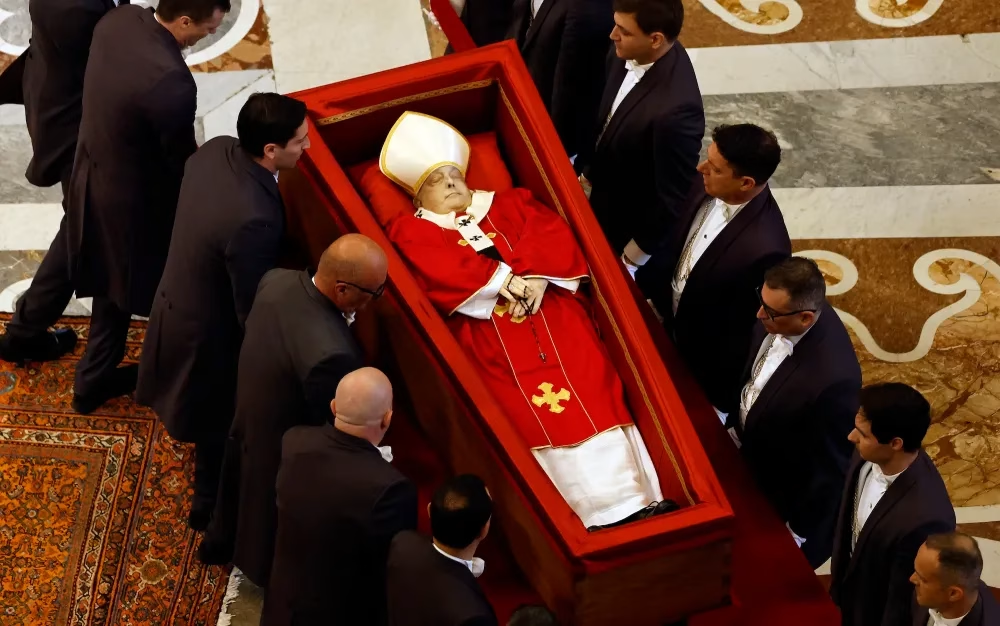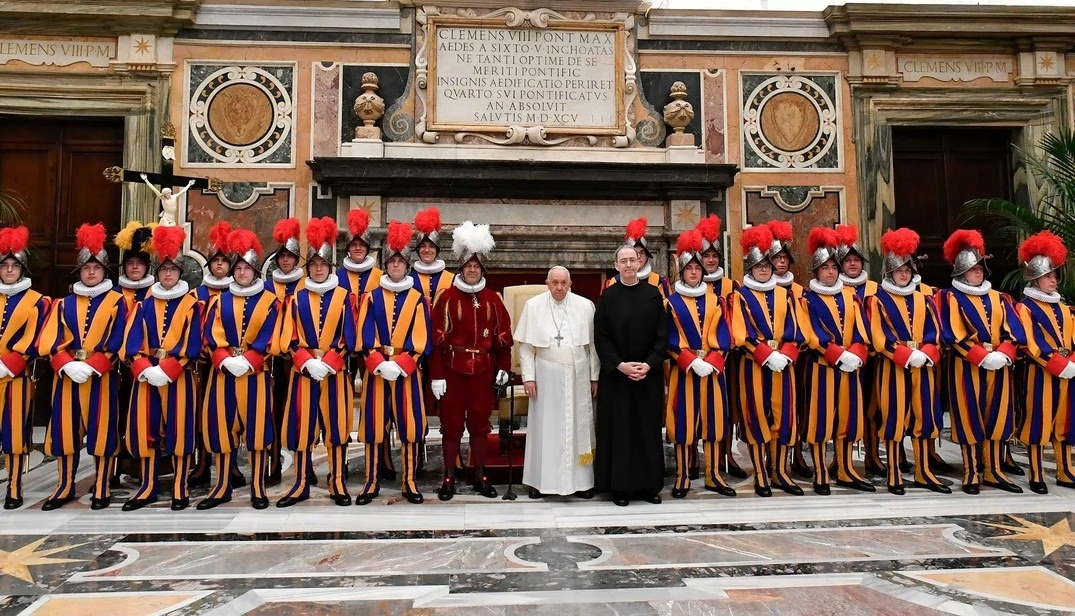By Tony Bruce & Ben Emos | Friday, April 25, 2025 | 8 min read
Tucked within the fortified walls of Vatican City—where centuries of history whisper through cobblestone corridors and Michelangelo’s dome watches silently overhead—stands the most curious military force on earth. They’re not who you’d expect. No tanks. No drones. Just 150 men in candy-colored Renaissance uniforms, armed with halberds and centuries of unshakable purpose. They are the Pontifical Swiss Guard—the smallest army in the world, and arguably, the most mysterious.
A Brotherhood Forged in Blood and Benediction
The story begins in 1506. Pope Julius II, known as the “Warrior Pope,” summoned Swiss mercenaries to Rome. Back then, Swiss fighters had a fearsome reputation—disciplined, loyal, and, crucially, immune to Roman corruption. These weren’t just soldiers. They were chosen defenders of the papacy.
Their defining moment—etched in legend and memorialized in marble—came during the Sack of Rome in 1527. When an army of tens of thousands descended on the city, 147 Swiss Guards held their ground, buying enough time for Pope Clement VII to escape. Nearly all of them died. Their sacrifice wasn’t just remembered—it became the soul of the Guard itself. Today, new recruits still raise their right hand and swear to defend the Pope with their lives. That’s not just ceremony. It’s a living promise.
Who Are These Men?
Strip away the armor, and you’ll find something rarer than the uniform: conviction. To become a Swiss Guard is to step into a life of discipline and devotion, not just to the Church, but to a concept of service that feels almost out of step with our hyper-individualistic world.
Candidates must be male, single, devoutly Catholic, Swiss citizens with completed military service and a spotless record. They’re not mercenaries. They’re believers. Men who, in their early twenties, choose not to chase fast money or cushy careers—but to guard a spiritual leader in a city-state smaller than New York’s Central Park.
It’s not glamorous work. There are no parades of ego here. No TikToks of tactical takedowns. These soldiers stand in the shadow of saints and martyrs, bound by duty that doesn’t end at sunset.
Ceremonial Halberds, Tactical Minds
At first glance, they look like they’ve stepped out of a Raphael painting. But don’t mistake the theatricality for weakness. Underneath those puffed sleeves and plumed helmets are trained warriors. In addition to their halberds—symbolic relics of medieval warfare—they’re skilled in modern tactics: automatic weapons, hand-to-hand combat, and threat neutralization.
Yes, they pose in tourist photos and march in ancient pageantry—but they’re also the guys scanning the crowd when the Pope wades into St. Peter’s Square, eyes sharp for danger in a sea of adoration.
Behind the Walls
The Vatican is many things—a pilgrimage site, a political powerhouse, a sanctuary of mystery. For the Swiss Guard, it’s also home. They live in shared barracks just steps from the Apostolic Palace. Their lives follow a rhythm that feels almost monastic: morning prayer, drills, guard rotations, and language classes. Some study at Roman universities. A few marry, with Vatican permission. And through it all, they live as brothers—bound not just by service, but by something older and deeper.
You won’t find many leaks or scandalous memoirs coming out of the barracks. Their world is cloistered for a reason. Silence is part of the job.
The Pope Has Died—Now What Do the Swiss Guards Do?
When the leader of the Catholic Church passes away, the Swiss Guards shift into a highly specialized protocol that has evolved over centuries.

As Pope Francis’ health made headlines earlier this year, many wondered: What exactly do these Swiss soldiers do when there is no Pope to protect? That question became real on Easter Monday, when Pope Francis passed away at the age of 88. Almost immediately, the Swiss Guards initiated a time-honored ritual—transitioning from protectors to caretakers of the sede vacante, the period during which the papal seat is vacant.
Their role becomes paradoxical: they are without a leader, yet they must guard the very heart of the institution. Security is tightened. Entry points to the Apostolic Palace are sealed. Only essential personnel—cardinals, officials of the Camerlengo’s office, and select clergy—are allowed in. The guards do not stand down; they stand watch. They are the guardians of a Church in suspense.
Papal Funeral: The Last Watch
The funeral of a pope is among the most solemn rituals in Vatican tradition, and the Swiss Guard plays a quietly powerful role. As mourners line St. Peter’s Square and global cameras roll, it is the guards who keep vigil beside the casket—sometimes for hours—without movement, without expression. This silent honor guard is not merely decorative; it’s a gesture of fidelity that spans centuries.
They walk beside him one last time. The Swiss Guards, in full ceremonial dress, escort the Pope’s remains from the Apostolic Palace through St. Peter’s Square, their steps steady and solemn. The path ends at the basilica—or at least, it usually does. For centuries, this has been the final ritual of protection: the guards accompanying the pontiff to the Vatican Grottoes, where so many of his predecessors now rest beneath layers of stone and history.
But Pope Francis chose a different ending.
In one of his final public reflections, Francis quietly shared his wish to be buried not under St. Peter’s Basilica, but in the Basilica of St. Mary Major, tucked near Rome’s main train station. It wasn’t about breaking tradition for the sake of it. For Francis, it was personal.
He had always seen himself first and foremost as the bishop of Rome, not a monarch of the Church. And he held a deep devotion to a centuries-old icon of the Madonna housed in St. Mary Major—a simple image of the Virgin Mary that he often visited in silence, before and after major journeys. That icon meant something to him. It was comfort. It was prayer.
And so now, instead of resting beneath the Vatican with popes past, Pope Francis lies in the city he served, near the people and the image he loved. The Swiss Guards still stood watch during his final journey—but this time, their steps veered from tradition, just as his did.
It was, in the end, a final act of humility. And a quiet nod to the city he never stopped calling home.
Conclave and Sacred Secrecy
Once the papal funeral is complete, the College of Cardinals begins preparations for the conclave—the secret election of a new pope. During this time, the Swiss Guard’s role becomes even more crucial.
They are tasked with sealing the Sistine Chapel and securing the Domus Sanctae Marthae, where the cardinals reside. No phones. No communication with the outside world. The Swiss Guard is not just present—they’re the sentinels of secrecy. Any breach, even accidental, is treated with the utmost gravity. Guards monitor every access point, every hallway, every doorway that might become a passage of influence or espionage.
They are also among the first to know when white smoke rises—signaling the birth of a new pontificate.
Why Do They Still Serve?
In a time when loyalty is often for sale and institutions bend with the wind, the Swiss Guard endures. Their reasons for serving aren’t always easy to articulate in a soundbite. Some do it for faith. Others for tradition. Many are pulled by the weight of history—by the idea that, in a fractured world, they can still be part of something pure.
They don’t claim to be special. But their presence—steady, ceremonial, and yet intensely practical—speaks volumes. When the Pope travels, they travel. When he prays, they stand guard. And if danger strikes, they are the last line.
A Living Relic
The Swiss Guard is more than a military unit. It’s a time capsule that breathes. A paradox in boots and armor. In a world where armies are built to project power, these men exist to protect a single soul—the Bishop of Rome. And in doing so, they protect something even greater: continuity. Faith. Meaning.
In their silence, in their stillness, in their solemn stares under the Roman sun—they remind us that some oaths still matter. Some uniforms are still sacred. And some warriors fight not for conquest or profit, but for something immortal.
As long as the keys of St. Peter rest in the Vatican, the Swiss Guard will be there—quietly vigilant, beautifully anachronistic, and utterly uncompromising.
They are, after all, the Pope’s soldiers. And some jobs are too sacred to modernize.
Copyright 2025 FN, NewsRoom.






